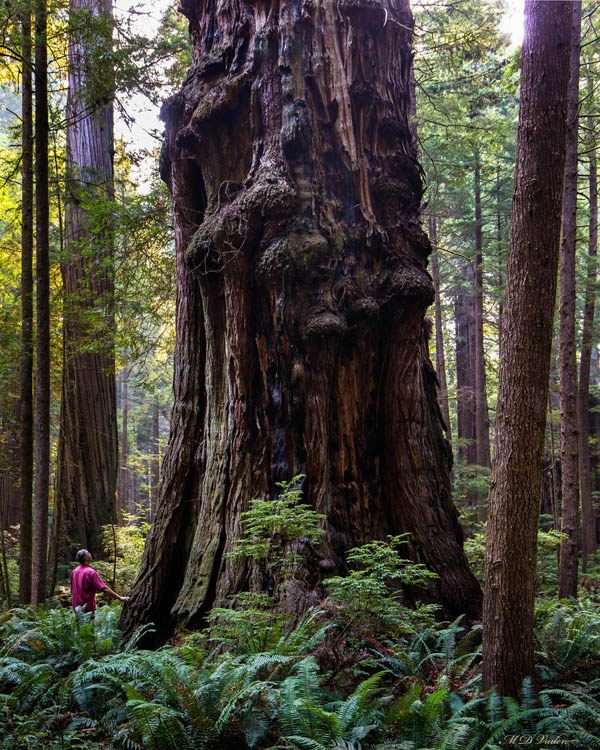In years gone by many giant tree discoveries have been named and publicized including a bunch of coast redwoods and giant sequoias. Almost everybody I ever met was comfortable with that tradition, until about six years ago. A contrary philosophy emerged from some researchers and rangers, who think it’s better to not give names to redwoods. They feel that way after National Geographic and Richard Preston publicized some coast redwood discoveries. Afterward some people started “getting on their case” when locations were not released at park visitor centers. And eventually a few locations leaked on social media, followed by wear and tear around certain coast redwoods. This led to more more complications for decision-making. Therein lies the origin of what prompted their change of heart.
Continue reading below image …
Their wishes have good intentions, but experience and facts prove their new way of thinking may be futile. And one example can explain why. Before the name for Chesty Puller coast redwood was established online, various people started calling it The Fused Titan instead. That proves if we don’t name a redwood, others will do it anyway. If you don’t want a redwood to become a celebrity, names don’t matter. The only option may be concealing a discovery’s existence altogether. Furthermore, any research reports connected to noteworthy redwoods would have to be hidden entirely because seekers still compile those kind of information fragments and formulated an identity. Suppose Hyperion had not been named in 2006, but simply published as the tallest redwood. The result would simply be a celebrity name “The World’s Tallest Tree” … boring name, but it’s still a name.
My approach is somewhere between. I name practically every coast redwood discovery to keep track of them. I publish a few names … but not all. We found that the real problem to vegetation was publishing the park where the superlatives grow if the location is basically unknown to the general populace.
This reminds of something different but related in several ways … the species-naming history of Coast Redwood and Giant Sequoia. Long ago, the coast redwoods were discovered and named Sequoia sempervirens. Then in the 1850’s, the giant sequoias (found amidst the California Gold Rush) were documented by the scientific community. Although others had spotted giant sequoia before, what set things in motion was a hunter Augustus Dowd, reporting his find near present-day Calaveras Big Trees State Park, in 1852.
The next summer, he sent foliage and cones to Albert Kellogg, physician & amateur botanist in San Francisco. Kellogg had everything needed to name the new species. But Kellogg delayed and triggered events that fueled scientific and diplomatic arguments for years to follow.
Kellogg distributed the Big Tree knowledge openly, and it was intercepted by an Englishman, William Lobb, who was visiting California collecting plants for an English nursery. Lobb returned to England, arriving December 1853, with the big tree’s foliage, cones and seedlings. Lobb shared these with John Lindley, a foremost botanist in England.
Lindley, recognized the importance of the large trees, then wrote a formal botanical description, then published it December 24, 1853. Thinking the new discovery had no near relatives, he assigned a new genus – Wellingtonia. Word reached the United States that an Englishman formally named the huge new (American) species after the British general who defeated Napoleon. Americans were furious about this. English defended Wellingtonia while American counterparts argued for alternatives, including Washingtonia.
Eventually, a Frenchman, Joseph Decaisne suggested a solution that the new giant trees are so closely related to already named redwoods along California coast, that they should be in the same genus. Since 1847, the coast redwoods were called Sequoia sempervirens, a name applied by Austrian botanist Stephen Endlicher. Following Decaisne’s suggestion, the big trees of the Sierra became Sequoia gigantea. The name was used scientifically until 1939. Today, scientists call them Sequoiadendron giganteum.
The problem we see today with common names stemmed from a tree not getting a name from one person, then others giving it a name anyway.
This is why coast redwood is the only “Sequoia” and Sequoiadendron of the Sierra Nevada is nicknamed “giant sequoia”. The common name was probably coined because a lot of people probably had no idea at the time that coast redwoods remained in those forests immensely larger than any giant sequoia seen standing today. In those days, “giant sequoia” would have been fitting for coast redwood’s common name too.
A closing note: the name sequoia, is assumed by many to commemorate a famous Cherokee Indian named Sequoyah. But apparently, there isn’t a shred of evidence to substantiate any part of this.
Endlicher never documented the name sequoia. No connection between Endlicher and Sequoyah has been found. – no proof that he “named the big red trees for a famous red man,” as described years ago. The entire Cherokee Indian name seems to boil down to the arena of campfire stories that people accept on blind faith.


Recent Comments